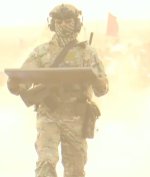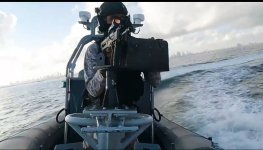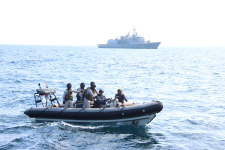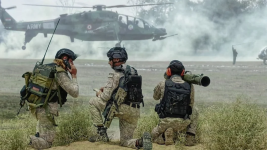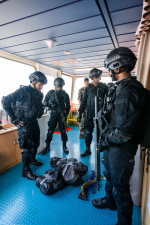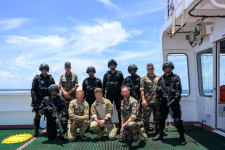Indian Special Forces
- Thread starter Parthu
- Start date
You are using an out of date browser. It may not display this or other websites correctly.
You should upgrade or use an alternative browser.
You should upgrade or use an alternative browser.
Navy To Build State-Of-The-Art Combat Training Centre in Karwar
The Indian Navy has started the process to build a state-of-the-art Combat Training Centre (CTC) in Karwar, a seaside city in Karnataka, to train its personnel, MARCOS commandos and special forces of foreign countries.
The integrated facility will come up on a 75-acre land with modern facilities in a major push to enhancing training of the special forces to take on terrorists and pirates.
As per details exclusively accessed by CNN-NEWS18, the training facility will have simulators and modular buildings, like a ‘multilevel kill-house’, an oil rig mock-up, a ship mock-up, a pool capable of wave generation to mock various sea-states, a mock-up of an urban city centre, a mock-up of a village, and an obstacle-cum-jungle firing range. The Indian Navy is engaging a consultant for preparation of the Detailed Project Report.
“The Project would be utilised for training of MARCOS, Indian Navy personnel, and Special Forces of Friendly Foreign Countries (FFC) and trials of newly inducted equipment," as per a document seen by CNN-NEWS18.
MARCOS are the commandos of Indian Navy used for anti-terror operations. This will be one of the most advanced training centres in India, an official said.
This will incorporate different designs like hotel lobbies, rooms, conference halls, offices of different sizes, ships’ machinery and living spaces, etc to bring about vitality in training. It will have ballistic protection to enable firing from various weapons including sniper weapons. The fittings will enable simulating various hostage scenarios.
This will be a composite structure consisting of simulators of an oil rig mock-up, a ship mock-up, a pool capable of wave generation to simulate various sea-states, and an Obstacle-cum-Jungle Firing Range. The oil rig mock-up target will be built to scale of an original oil rig platform so as to depict various levels of the platform, namely Jacket Deck, Main Deck, Living Quarters and a Top Deck (Helipad). A ship mock-up target will represent sections of ship’s side, weather deck and superstructure of a merchant ship.
This would be a tactical training facility with modern training aids for Military Operations in Urban Terrain Complex. The facility would consist of two compounds which include an urban setup similar to a town or city and one rural setup similar to an Indian village. The urban facility would consist of a minimum of 10 multi-storey buildings with a total of a minimum of 50 rooms similar to a town or city with realistic furniture and training props. The compound will be designed to replicate a city which would consist of a hospital, a police station, a radio station, a factory, a bank, a hotel, a movie theatre, a school, warehouses, administrative and civilian buildings, etc.
The buildings of the compound will be capable of supporting Special Helicopter Borne Operations such as slithering, rappelling etc. with one of the buildings capable of supporting helicopter landings.
The rural compound will be a mockup of a rural area or a village in India and consist of a cowshed, a temple, a Primary Health Centre, houses similar to mud houses, a crops storing facility etc with an open field or Helipad adjacent to the compound to support Special Helicopter Borne Operations.
The Indian Navy has started the process to build a state-of-the-art Combat Training Centre (CTC) in Karwar, a seaside city in Karnataka, to train its personnel, MARCOS commandos and special forces of foreign countries.
The integrated facility will come up on a 75-acre land with modern facilities in a major push to enhancing training of the special forces to take on terrorists and pirates.
As per details exclusively accessed by CNN-NEWS18, the training facility will have simulators and modular buildings, like a ‘multilevel kill-house’, an oil rig mock-up, a ship mock-up, a pool capable of wave generation to mock various sea-states, a mock-up of an urban city centre, a mock-up of a village, and an obstacle-cum-jungle firing range. The Indian Navy is engaging a consultant for preparation of the Detailed Project Report.
“The Project would be utilised for training of MARCOS, Indian Navy personnel, and Special Forces of Friendly Foreign Countries (FFC) and trials of newly inducted equipment," as per a document seen by CNN-NEWS18.
MARCOS are the commandos of Indian Navy used for anti-terror operations. This will be one of the most advanced training centres in India, an official said.
WHAT WILL THE COMBAT TRAINING CENTRE HAVE?
1. A THREE-STOREY MULTILEVEL KILL HOUSE
This will incorporate different designs like hotel lobbies, rooms, conference halls, offices of different sizes, ships’ machinery and living spaces, etc to bring about vitality in training. It will have ballistic protection to enable firing from various weapons including sniper weapons. The fittings will enable simulating various hostage scenarios.
2. MARITIME WORKUP STATION
This will be a composite structure consisting of simulators of an oil rig mock-up, a ship mock-up, a pool capable of wave generation to simulate various sea-states, and an Obstacle-cum-Jungle Firing Range. The oil rig mock-up target will be built to scale of an original oil rig platform so as to depict various levels of the platform, namely Jacket Deck, Main Deck, Living Quarters and a Top Deck (Helipad). A ship mock-up target will represent sections of ship’s side, weather deck and superstructure of a merchant ship.
3. MILITARY OPERATIONS IN URBAN TERRAIN COMPLEX
This would be a tactical training facility with modern training aids for Military Operations in Urban Terrain Complex. The facility would consist of two compounds which include an urban setup similar to a town or city and one rural setup similar to an Indian village. The urban facility would consist of a minimum of 10 multi-storey buildings with a total of a minimum of 50 rooms similar to a town or city with realistic furniture and training props. The compound will be designed to replicate a city which would consist of a hospital, a police station, a radio station, a factory, a bank, a hotel, a movie theatre, a school, warehouses, administrative and civilian buildings, etc.
The buildings of the compound will be capable of supporting Special Helicopter Borne Operations such as slithering, rappelling etc. with one of the buildings capable of supporting helicopter landings.
The rural compound will be a mockup of a rural area or a village in India and consist of a cowshed, a temple, a Primary Health Centre, houses similar to mud houses, a crops storing facility etc with an open field or Helipad adjacent to the compound to support Special Helicopter Borne Operations.
4. INDOOR FIRING RANGE WITH FIRING SIMULATOR COMPLEX
This will be an integrated firing range consisting of an Advanced Target System and a firing simulator for practising operational firing in various scenarios. There will also be an armoury for stowage of weapons, ammunition, explosives and special equipment. The entire integrated, access-controlled facility will have enhanced security perimeter fencing, CCTVs and a camouflage paint scheme for the entire facility.Lt Gen Anindya Sengupta, GOC-in-C, Central Command visited Shatrujeet Brigade to review operational readiness of the formation. The Army Cdr was briefed on all aspects of functioning and also taken on an aerial tour of the Garrison. He appreciated tech absorption and innovativeness of the formation in planning and conduct of multi modal operations including Airborne, Heliborne and Amphibious Ops, across varied terrain and theatres.






India boosting covert warfare capabilities of special forces
NEW DELHI: From midget submarines, loiter munitions and nano drones to specialised weaponry, surveillance and communication equipment, India is progressively strengthening the capabilities of its Special Forces to undertake covert warfare deep behind enemy lines as well as counter-terrorism operations.
The upgrade in the gruelling combat training, which will include “augmented reality/virtual reality mission planners and simulators” in the near future, as well as “specialised equipping” of the Special Forces in the Army, IAF and Navy is part of an ongoing process, sources told TOI.
There are now 10 Para-Special Forces and five Para (Airborne) battalions (each has around 620 soldiers) in the Army, 27 `flights’ of around 1,600 Garud commandos in IAF and over 1,400 marine commandos (Marcos) in Navy.
A major shortcoming, however, is the lack of a full-fledged Special Operations Command, which would bring the disparate Special Forces together under a unified command and control structure for planning and executing strategic operations instead of merely tactical ones.
Nevertheless, the creation of a truncated Armed Forces Special Operations Division (AFSOD) has somewhat addressed the issue of “jointness and synergy” among the Para-SF, Garuds and Marcos.
The induction of advanced software-defined radios, including manpack versions, and satellite-communication systems, for instance, have ensured “uninterrupted and seamless” long-range communications for joint operations among the three forces, the sources said.
The Special Forces already have a wide array of specialized weapons, ranging from Finnish Sako long-range sniper rifles, American M4A1 carbines and Israeli TAR-21 Tavor assault rifles to Swedish Carl Gustaf lightweight rocket launchers, Russian VSS suppressed sniper rifles and Italian Beretta pistols with silencers.
“The induction of loiter munition systems has boosted the precision-targeting capabilities of Para-SF units. Similarly, remotely-piloted aerial vehicles, nano drones, surveillance copters and lightweight drones with FLIR (forward-looking infra-red) payloads have been inducted for advanced short and medium-range surveillance up to 10-km,” a source said.
With stealth being paramount for insertion behind enemy lines, advanced indigenous `combat free-fall parachute systems’ and other such equipment have been inducted, while procurement of new `integrated combat diving kits’ is also underway. “Guided aerial delivery systems are now available to ensure commandos can operate independently behind enemy lines for longer durations,” another source said.
Given their maritime role, the Marcos in turn have midget submarines or sea chariots, underwater scooters, remotely-operated underwater vehicles for explosive disposal, open-circuit diving equipment and air-droppable rubberized inflatable boats, among other such things.
The selection and training for the Para-SF, Marcos and Garuds, which have a rejection rate as high as 70-80%, also remains a major focus area. The training, in which the volunteers are stretched to their physical and mental limits, includes operations for surgical strikes, hit-and-run missions, strategic and tactical surveillance of vital enemy targets, intelligence-gathering, laser-designated bombings and other such clandestine tasks.
The Army’s first vertical wind tunnel to enhance ‘combat freefall’ skills of its Special Forces and others is fully operational at the Special Forces Training School at Bakloh in Himachal Pradesh. “Simulators are now increasingly being used. The plan is to also induct AI-based systems soon to make the training more realistic and economical,” a source said.





